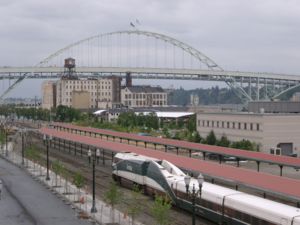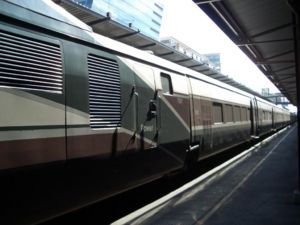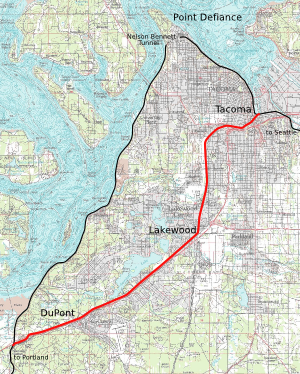Amtrak Cascades


The Amtrak Cascades (originally named Cascadia) is a passenger train route operated by Amtrak in partnership with the states of Washington and Oregon in the Pacific Northwest of the United States and Canada. It is named after the Cascade mountain range that the route parallels.
The corridor runs 156 miles (251 km) from Vancouver, British Columbia south to Seattle, Washington, continuing 310 miles (499 km) south via Portland, Oregon to Eugene, Oregon. Track capacity in British Columbia does not yet allow for through travel between the two ends, but Thruway Motorcoach connects travellers from Vancouver, BC to Seattle, provides additional services between Portland and Eugene, besides other Amtrak Thruway destinations in Washington and Oregon.
Cascades service on the Seattle-Portland route began in 1993. Total Amtrak Cascades ridership for 2005 was 636,892.[1]
Contents
Equipment
The Amtrak Cascades is a unique train that is painted in a special scheme. The train is normally operated in a push-pull configuration with an EMD F59PHI at one end, and a de-motored EMD F40PH locomotive called a Non-Powered Control Unit (NPCU) on the other end. The NPCU contains a cement weight, possibly to meet FRA weight requirements.
The passenger cars themselves are produced by Talgo, the only cars by that company in operation in the United States. These cars are designed to passively tilt into curves, allowing the train to pass through them at higher speeds. Despite a maximum design speed of 124 mph (200 kph), current track and safety requirements limit the train's speed to 79 mph.
The Talgo trainset is articulated – each passenger car in the Talgo set actually shares a single axle with the next, such that they cannot be decoupled without lifting one car onto a support. This design can also reduce jackknifing in a derailment.
A typical consist includes a baggage car; two business class coaches; one lounge/dining car; one cafe care; six standard coaches; and one service car. The lounge/dining car offers breakfast and dinner service on the Seattle-Vancouver B.C route.
The fins on the baggage and service cars serve only as an aesthetic transition from the high top of the American built locomotives to the roof of the low slung European designed passenger cars.
Station stops
Northbound trains are even-numbered; southbound trains are odd.
All station stops are made.
- Fairhaven Station, Bellingham
- Mount Vernon Station, Mount Vernon
- Everett Station, Everett
- Edmonds Station, Edmonds
- King Street Station, Seattle
- Tukwila Station, Tukwila
- Tacoma Station, Tacoma
- Centennial Station, Olympia-Lacey
- Centralia Railroad Depot, Centralia
- Kelso Multimodal Transportation Center, Kelso-Longview
- Vancouver Rail Station, Vancouver
- Union Station, Portland
- Oregon City Depot, Oregon City
- Salem Rail Station, Salem
- Albany Station, Albany
- Eugene Depot, Eugene
Funding
Funding for the route is provided separately by the states of Oregon and Washington, with Union Station in Portland serving as the dividing point between the two. As of July 1 2006, Washington state has funded four daily round trips between Seattle and Portland. Washington also funds two daily round trips between Seattle and Bellingham, with one of them extending north to Vancouver, BC. Oregon funds two daily round trips between Eugene and Portland. The five trainsets are organized into semi-regular operating cycles, but no particular train always has one route.
Local partnerships
As a result of Cascades service being jointly funded by the Washington and Oregon departments of transportation, public transit agencies and local municipalities can offer a variety of discounts, including companion ticket coupons.
- FlexPass and University of Washington UPass holders receive a 15% discount (code H610) on all regular Cascades travel. Employers participating in these programs may also receive a limited number of free companion ticket coupons for distribution to employees.
- The Sound Transit RailPlus program allows riders to use weekday Cascades trains between Everett and Seattle with the Sounder commuter rail fare structure.
- The Chinook Book coupon book offers a companion ticket coupon which does not require any particular origination/destination, and is valid until the end of 2006. The Chinook Book costs between $15 and $20.
The Cascades service also benefits from Sound Transit's track upgrades for Sounder service, notably the upcoming Point Defiance Bypass project.
Future plans
The WSDOT Rail Office plans for eventual service of 13 daily round trips between Seattle and Portland and 4-6 round trips between Seattle and Bellingham, with four of those extending to Vancouver, BC. Due to a vote by the Washington State Legislature in 2005, the fourth round trip between Seattle and Portland began operating on July 1, 2006.
These reductions in travel times are also planned:
- Seattle to Portland – 3:30 (2006); 2:30 (planned)
- Seattle to Vancouver BC – 3:55 (2006); 2:57 (planned)
- Vancouver BC to Portland – N/A (2006); 5:37 (planned)
In order to increase train speeds and frequency to meet these goals, a number of incremental track improvement projects must be completed. Gates and signals must be improved, some grade crossings must be separated, some track must be replaced or upgraded and station capacities must be increased. In order to extend the second daily Seattle to Bellingham round trip to Vancouver, BNSF must make track improvements north of the US-Canadian border, to which the government of British Columbia has been asked to contribute financially.
Vancouver to Seattle projects
Swift Customs Facility
- Adds a siding to allow freight trains to move off the mainline for Customs inspections; increases reliability for Vancouver to Seattle trains.
- Construction begins in Fall 2007 with expected completion in Summer 2009.
Bellingham Georgia Pacific upgrades
- Increases passenger train speeds near the Georgia Pacific plant from 20 mph to 30 mph.
- Upgrades warning and crossing equipment to improve safety for pedestrians and vehicles at Laurel and Central streets.
- Construction begins in 2008 with expected completion in 2009.
Bellingham Waterfront Redevelopment Project
- Relocates 0.75 miles of BNSF track to avoid the current sharp curve.
- Would increase passenger train speeds (presumably above 30mph).
- Construction begins in Fall 2007 with expected completion in Summer 2009.
Mt. Vernon siding upgrade
- Adds a siding to allow southbound trains from Bellingham to pass northbound trains from Seattle; allows for earlier southbound departure.
- Construction began in 2005 with expected completion in 2007.
Stanwood siding upgrade/repair
- Lengthens and repairs siding to ensure freight trains are accommodated; increases reliability for Vancouver and Bellingham to Seattle trains.
- Construction begins in 2007 with expected completion in 2009.
Everett PA Junction and Delta Yard Realignment
- Realigns sharp curves to increase passenger train speeds from 30mph to 50mph, resulting in a two minute time savings to Bellingham and Vancouver.
- Upgrades warning and crossing equipment to improve safety for pedestrians and vehicles at Pacific/Chestnut crossing and Railroad Avenue crossing.
- Construction was supposed to begin in September 2006, but issues with completion of the engineering and environmental reports have pushed the anticipated start date to May 2008, with completion in July 2009.
King Street Station track improvements
- Allows more trains to access the station at one time.
- Construction began in October 2006 with expected completion in Winter 2011.
Seattle to Portland projects
Point Defiance Bypass
- Partnership with Sound Transit to bypass BNSF Railway Puget Sound shore track for an alignment between Tacoma at the north end and the Nisqually River at the south.
- Increases train speeds in this corridor with a straighter track alignment.
- Eliminates the need for Cascades trains to use the single-track Nelson Bennett Tunnel, although Coast Starlight trains will likely continue to use the coastal alignment due to the steep grade from Tacoma to Lakewood.
- First phase decreases travel time through the corridor by 6 minutes; second phase decreases travel time by at least another 5 minutes.
- Sound Transit construction was originally scheduled to be complete in late 2007 or early 2008, but was delayed: The F59PHI locomotives used by Sounder Commuter Rail cannot climb the steep grade south of Tacoma in wet weather, so a different design to level the incline must be used. Funding for WSDOT's portion of the project has been moved forward by four years to 2007 so their construction may coincide with Sound Transit's. As a result, WSDOT construction is scheduled to begin in 2007 with an anticipated completion date in 2010.
Kelso-Martin's Bluff Rail Project
- Constructs a third mainline from Kelso to Martin's Bluff, allowing for more frequent passenger service.
- Upgrades warning and signal equipment at four crossings, improving safety for vehicles and pedestrians.
- Construction is scheduled to begin in 2009 with an anticipated completion date in 2013.
Vancouver Rail Project
- Constructs a double-tracked bypass alignment to decrease freight congestion and to increase passenger train reliability.
- Constructs a crossing over the tracks at W. 39th St, increasing vehicle and pedestrian safety.
- Construction is scheduled to begin in 2007 with an anticipated completion date in 2011.
High-speed crossovers
These projects allow trains to switch mainlines at higher speed, reducing time lost when passing another train.
- Titlow
- Centennial
- Tenino
- Chehalis
- Newaukum
- Winlock
Grade separations
These projects remove a crossing by creating either a rail or road bridge, allowing for higher train speeds and the best possible crossing safety.
- S. Lander Street (Seattle)
- Royal Brougham SR 519 Phase 2 (Seattle)
- S. 212th Street (Kent)
- Willis Street (Kent)
| Amtrak routes |
|---|
References
- Amtrak Cascades timetable (PDF) Retrieved September 9, 2006
- Amtrak Cascades Draft 20-year Plan (Washington State) (PDF) Retrieved June 25, 2006
- Washington State Department of Transportation Rail Page Retrieved September 19, 2005
- 2005 Washington State Transportation Tax Package Retrieved September 19, 2005
- WSDOT Public Transportation and Rail Monthly Report - April 2005 Retrieved September 20, 2005
- WSDOT December 2005 Quarterly Project Report for PA Junction Curve Realignments and Delta Yard Storage Tracks Retrieved March 3, 2006
- ↑ Washington State Department of Transportation (2006-01-30). Amtrak Cascades Announces Record Ridership for 2005. Press release. Retrieved on 2008-02-28.
External links
- Amtrak - Amtrak Cascades (Amtrak official site)
- Amtrak Cascades (Washington State official site)

